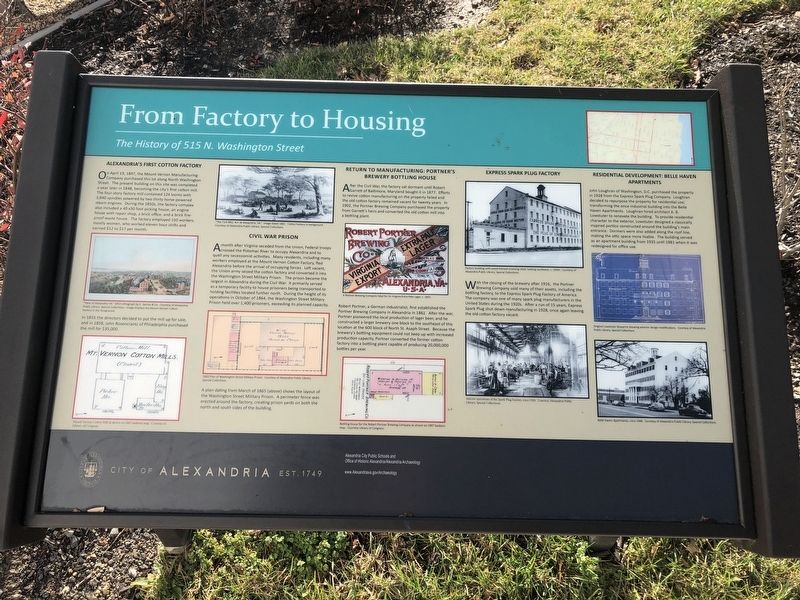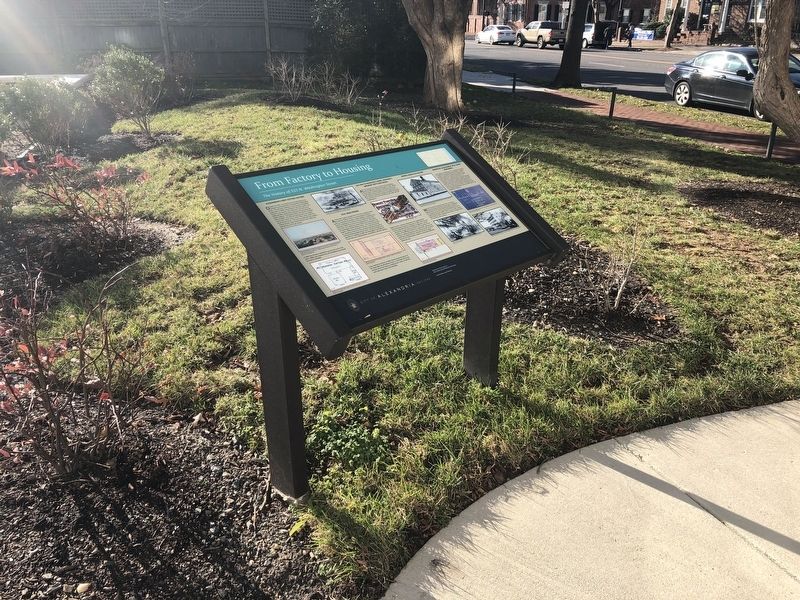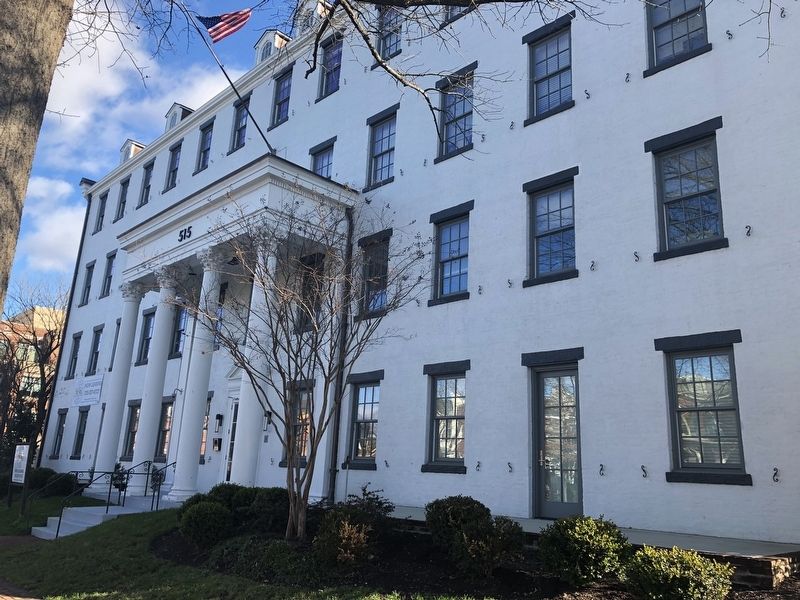Old Town West in Alexandria, Virginia — The American South (Mid-Atlantic)
From Factory to Housing
The History of 515 N. Washington Street
— City of Alexandria, est. 1749 —
On April 19, 1847, the Mount Vernon Manufacturing Company purchased this lot along North Washington Street. The present building on this site was completed a year later in 1848, becoming the city's first cotton mill. The four-story factory mill contained 124 looms with 3,840 spindles powered by two thirty horse-powered steam engines. During the 1850s, the factory complex also included a 40x50 foot picking house, an engine house with repair shop, a brick office, and a brick fireproof waste house. The factory employed 150 workers, mostly women, who worked eleven hour shifts and earned $12 to $17 per month.
In 1855 the directors decided to put the mill up for sale, and in 1858, John Rosencrantz of Philadelphia purchased the mill for $35,000.
A month after Virginia seceded from the Union, Federal troops crossed the Potomac River to occupy Alexandria and to quell any secession activities. Many residents, including many workers employed at the Mount Vernon Cotton Factory, fled Alexandria before the arrival of occupying forces. Left vacant, the Union army seized the cotton factory and converted it into the Washington Street Military Prison. The prison became the largest in Alexandria during the Civil War. It primarily served as a temporary facility to house prisoners being transported to holding facility to house prisoners being transported to holding facilities located farther north During the height of its operations in October of 1864,the Washington Street Military Prison held over 1,400 prisoners, exceeding its planned capacity.
A plan dating from March of 1865 (above) shows the layout of the Washington Street Military Prison. A perimeter fence was erected around the factory, creating prison yards on both the north ad south sides of the building.
After the Civil War, the factory sat dormant until Robert Garrett of Baltimore, Maryland bought it in 1877. Efforts to revive cotton manufacturing on the property failed and the old cotton factory remained vacant for twenty years. In 1902, the Portner Brewing Company purchased the property from Garrett's heirs and converted the old cotton mill into a bottling plant.
Robert Portner, a German industrialist, first established the Portner Brewing Company in Alexandria in 1861. After the war, Portner pioneered the local production of lager beer, and he constructed a larger brewery one block to the southeast of this location at the 600 block of North St. Asaph Street. Because the brewery's bottling equipment could not keep
With the closing of the brewery in 1916, the Portner Brewing Company sold many of their assets, including the bottling factory, to the Express Spark Plug Factory of America. The company was one of many spark plug manufacturers in the United States during the 1920s. After a run of 15 years, Express Spark Plug shut down manufacturing in 1928, once again leaving the old cotton factory vacant.
John Loughran of Washington, D.C. purchased the property in 1928 from the Express Spark Plug Company. Loughran decided to repurpose the property for residential use; transforming the once industrial building into the Belle Haven Apartments. Loughran hired architect a. B. Lowstuter to renovate the building. To provide residential character to the exterior, Lowstuter designed a classically inspired portico constructed around the building's main entrance. Dormers were also added along the roof line, making the attic space more livable. The building served as an apartment building from 1935 until 1981 when it was redesigned for office use.
Erected by
Topics and series. This historical marker is listed in these topic lists: Industry & Commerce • War, US Civil. In addition, it is included in the Virginia, The City of Alexandria series list. A significant historical month for this entry is March 1865.
Location. 38° 48.609′ N, 77° 2.74′ W. Marker is in Alexandria, Virginia. It is in Old Town West. Marker is on North Washington Street south of Pendleton Street, on the right when traveling north. Touch for map. Marker is at or near this postal address: 515 North Washington Street, Alexandria VA 22314, United States of America. Touch for directions.
Other nearby markers. At least 8 other markers are within walking distance of this marker. Washington-Rochambeau Route (within shouting distance of this marker); Potts-Fitzhugh-Lee House (within shouting distance of this marker); Lee-Fendall House (within shouting distance of this marker); a different marker also named Lee-Fendall House (within shouting distance of this marker); Home of Edmund Jennings Lee (about 300 feet away, measured in a direct line); Grosvenor Hospital (about 400 feet away); American Red Cross (about 500 feet away); Historic Street (about 600 feet away). Touch for a list and map of all markers in Alexandria.
Credits. This page was last revised on May 25, 2023. It was originally submitted on December 24, 2018, by Devry Becker Jones of Washington, District of Columbia. This page has been viewed 466 times since then and 49 times this year. Photos: 1, 2, 3. submitted on December 24, 2018, by Devry Becker Jones of Washington, District of Columbia. • Andrew Ruppenstein was the editor who published this page.


